Description
Large Trumpet Shaped Flowers are Showcased Against Deep Green Foliage
The Dipladenia, or Rock Trumpet, is one of the best choices if you are looking for a vining plant that can produce a multitude of colored flowers depending on the variant. This plant comes with five petal flowers that are shaped like a trumpet. These flowers can be found in white, red, and pink colors. The Mandevilla sanderii grows in subtropical and tropical climates, and the flowers bloom in summer and can go further into fall. However, if you grow the plant in a warm climate, then the flowers will continue to bloom throughout the year.
These plants are best for twining on rails or on the wall. You can also keep them in a container and place them on the porch. Native to South and Central America, the Rock Trumpet can be a valuable addition to your space.
Caring for your Dipladenia
If you follow the right care guide, it is not difficult to take care of the Mandevilla plants. These plants are friendly and do not demand strict conditions to grow properly. However, you must follow the right protocol. Here is a care guide that can help you.
Light
This plant loves the sun! If you want it to grow properly, then it is a great idea to keep it outdoors so it can get the maximum amount of light. But if you want to keep it indoors, you can keep it near a window so that it gets as much light as possible. The plant is, however, tolerant to partial shade and can grow properly.
On the other hand, if the sunlight is harsh, then you can shift the plant inside so it does not scorch under the blazing sun.
Soil
To grow Dipladeniai, you must have well-draining sandy soil. To boost your plant, you can include organic materials in the mix. You can choose leaf mold, peat moss, and sand for the potting mix. The soil can be anywhere between neutral to slightly acidic when it comes to the pH level. However, if you have no choice, the plant will not fuss even if you use slightly alkaline soil.
Water
While it is a flowering plant, this specie can go without a lot of water. However, you need to make sure that the soil remains moist for the most part. Keep a watchful eye on the soil so you can keep it damp. However, do not overwater your plants as that will significantly damage the roots and affect their growth. When watering, do not pour all of the water at the same time. You must slowly pour the water so that the plant can easily soak it all up. You can also spray the leaves, which will not only keep them moisturized but also brush off any pests on the leaves.
Fertilizer
It is best to use a balanced slow-release fertilizer so that your plant can get the nutrients it needs over time without overpowering it. If you want, you can also use a liquid fertilizer that is at half-strength. The best time to add fertilizer is between spring and fall. You can add a little bit of compost, too, to increase the strength of the soil.
Common Issues
On the whole, these plants do not suffer from many pests and diseases. However, like all plants, they can also be affected by some common problems.
Pests
Pests like spider mites, aphids, and whiteflies are very common for the Rock Trumpet. They can cause leaf damage to the plants and even cause discoloration. If you want your plant to stay as healthy as possible, you will have to eliminate all the posts. You can use an insecticidal soap or even neem oil to get rid of the pests and heal the infestation.
Disease
Some of the diseases for Dipladenia include yellow leaves, browning of leaves, and spots. These diseases are a result of not taking good care of your plants. If you make sure to give your plants the water they need, along with the right amounts of sunlight, you won’t have to worry about these diseases.
Pruning
It is good to prune your rock trumpet once every year. You can ensure that the plant is tidy and flowering properly by pruning it in the winter or early spring. Pruning at the right time will give you the best results.
Propagation
You can propagate the plant using its cuttings. Cut around 4-6 inches below the leaf node and then you can plant it in a container of moist soil.
Potting/Repotting
To choose the container for your Mandevilla sanderii, you must go for a size that is only slightly bigger than the root ball. If you get a pot that is too big, the roots will continue to expand, and the plant will not grow how you want it to.

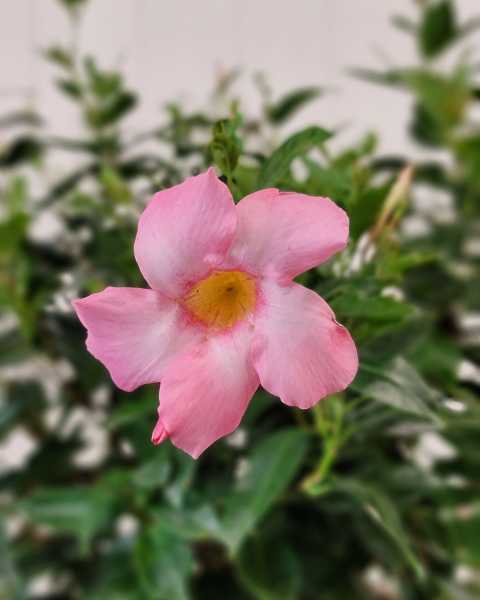
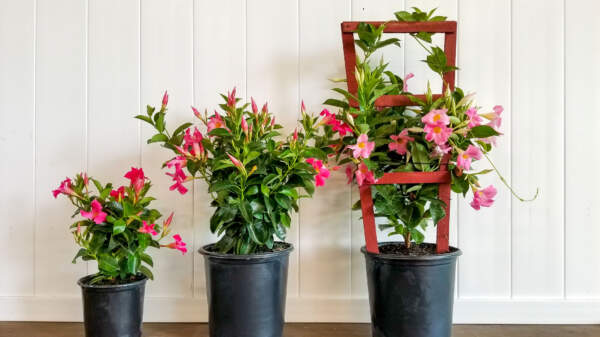
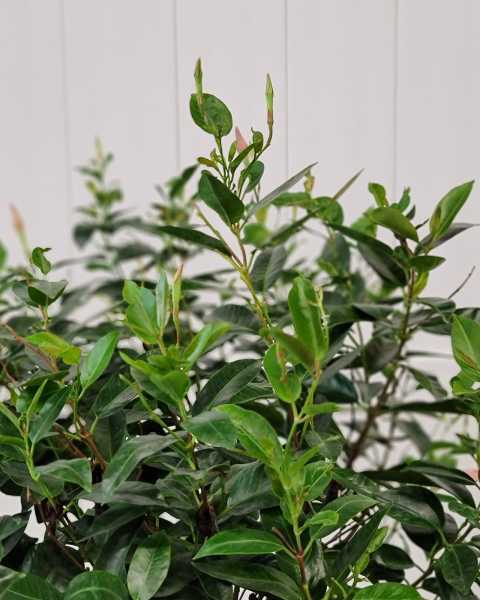
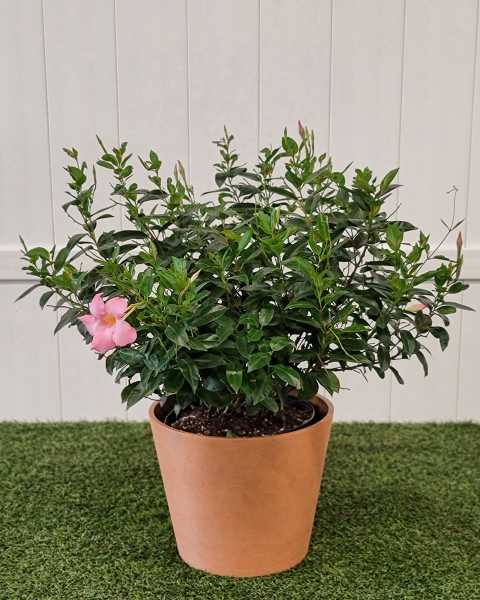
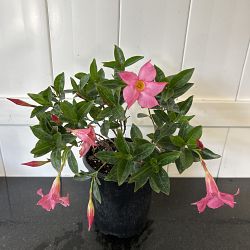
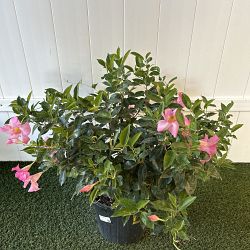
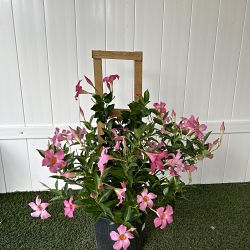



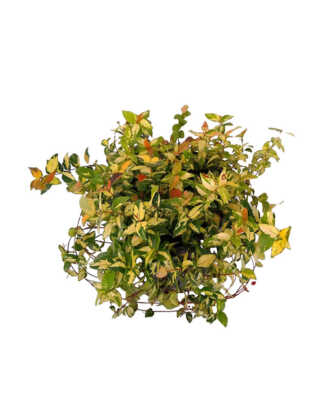
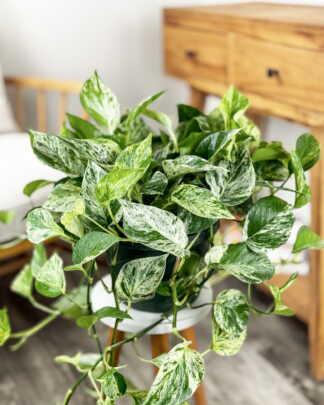
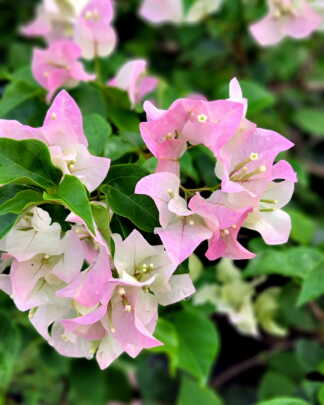

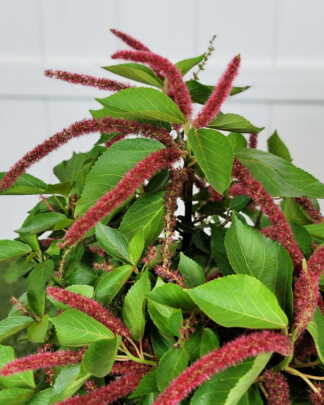


Anonymous (verified owner) –
Beautiful flowers. Arrived on time and in good condition.
Anonymous (verified owner) –
Karen Teeter (verified owner) –
Arrived in beautiful shape and lots of flowers!
Ann (verified owner) –
Speedy delivery, item as desribed – appears to be doing well – so far.
Karen Miller (verified owner) –
How do I send you a photo ? No matter how I try I can’t send one.
Chris N Camlin (verified owner) –
Gorgeous, beautiful, arrived in perfect condition, thank you very much.
Kathleen Mann (verified owner) –
My plant arrived on schedule and in great condition! It is thriving on my deck and the blooms are beautiful!
John Vosevich (verified owner) –
Very pleased with the plant and the service.
Cynthia (verified owner) –
Just beautiful!!
JULIE A. (verified owner) –
I love my mandevilla plant , but it wasn’t the same color as the picture. The flowers are budding and opening up but they are a pale, pastel pink color..not a vibrant pink like shown in picture. The packaging was great ..the dirt was cover with a plastic seal with no spills..
Beverly Edwards (verified owner) –
Soso not as good
Anonymous (verified owner) –
nice size and full of flowers
Charlesana (verified owner) –
Even though Fed-X delivered my plant upside down in the box, it was so well packaged it wasn’t ruined.
Barbara (verified owner) –
I had had my plants a week now, and they lost some leaves and buds, but, are doing well. getting new buds – gorgeous – well packed and arrived in good shape
mary d. (verified owner) –
Arrived in good shape – beautiful plant! Thank you
Daniel Rifkin (verified owner) –
Frances obrien (verified owner) –
Sharon Baker (verified owner) –
Great plant!
Thanks
Patricia Burt (verified owner) –